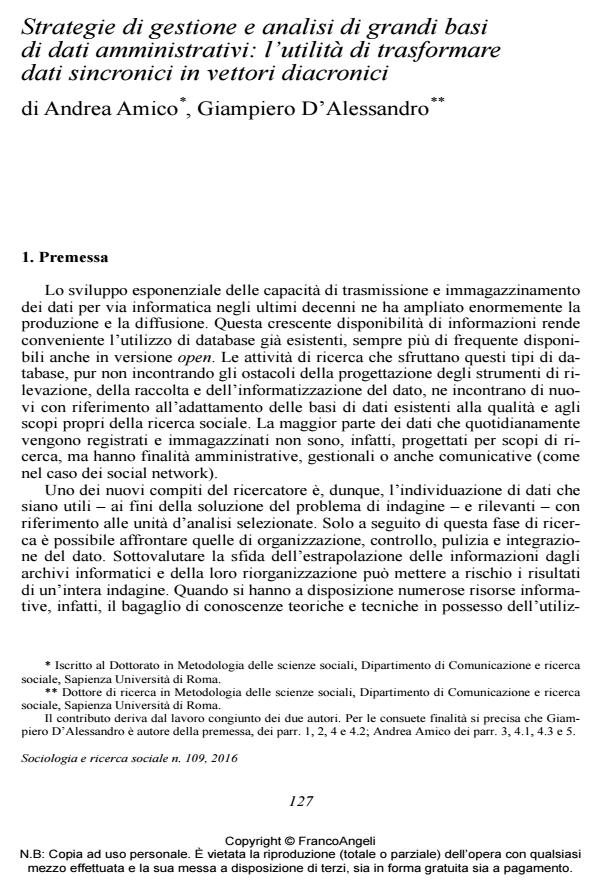Large Databases of Administrative Data: Management and Analysis Strategies. The Benefit of Transforming Synchronic Data in Diachronic Vectors
Journal title SOCIOLOGIA E RICERCA SOCIALE
Author/s Andrea Amico, Giampiero D'Alessandro
Publishing Year 2016 Issue 2016/109
Language Italian Pages 16 P. 127-142 File size 95 KB
DOI 10.3280/SR2016-109011
DOI is like a bar code for intellectual property: to have more infomation
click here
Below, you can see the article first page
If you want to buy this article in PDF format, you can do it, following the instructions to buy download credits

FrancoAngeli is member of Publishers International Linking Association, Inc (PILA), a not-for-profit association which run the CrossRef service enabling links to and from online scholarly content.
The ever-increasing availability of information, together with the higher (time and financial) costs of data gathering, makes the use of pre-existing databases more and more convenient. The majority of the data gathered and recorded each day is not designed for research purposes however. It is still a task of each researcher to choose the relevant data in consideration of the research objectives, and to organize his own database according to his research purposes. The case study presented is the construction of a longitudinal dataset using synchronic data extracted from the administrative archive of the Sapienza University of Rome, and referred to the registered students’ careers. This dataset fits the purpose of studying the temporal dynamics and allows the analysis of specific phenomena (dropping-out, stopping-out, mobility, degree rates, etc.). Three different analysis on this dataset are presented, that highlight the usefulness of this kind of data structure: a quasi-experimental design, a sequence analysis and an event history analysis.
- Research on Students' Performance in Higher Education through Sequence Analysis Giampiero D'Alessandro, Alessandra Decataldo, in SOCIOLOGIA E RICERCA SOCIALE 110/2016 pp.19
DOI: 10.3280/SR2016-110003 - La Sequence Analysis come strumento per lo studio delle carriere e della dispersione universitaria Giampiero D’Alessandro, in RIV Rassegna Italiana di Valutazione 65/2017 pp.82
DOI: 10.3280/RIV2016-065006
Andrea Amico, Giampiero D'Alessandro, Strategie di gestione e analisi di grandi basi di dati amministrativi: l’utilità di trasformare dati sincronici in vettori diacronici in "SOCIOLOGIA E RICERCA SOCIALE " 109/2016, pp 127-142, DOI: 10.3280/SR2016-109011